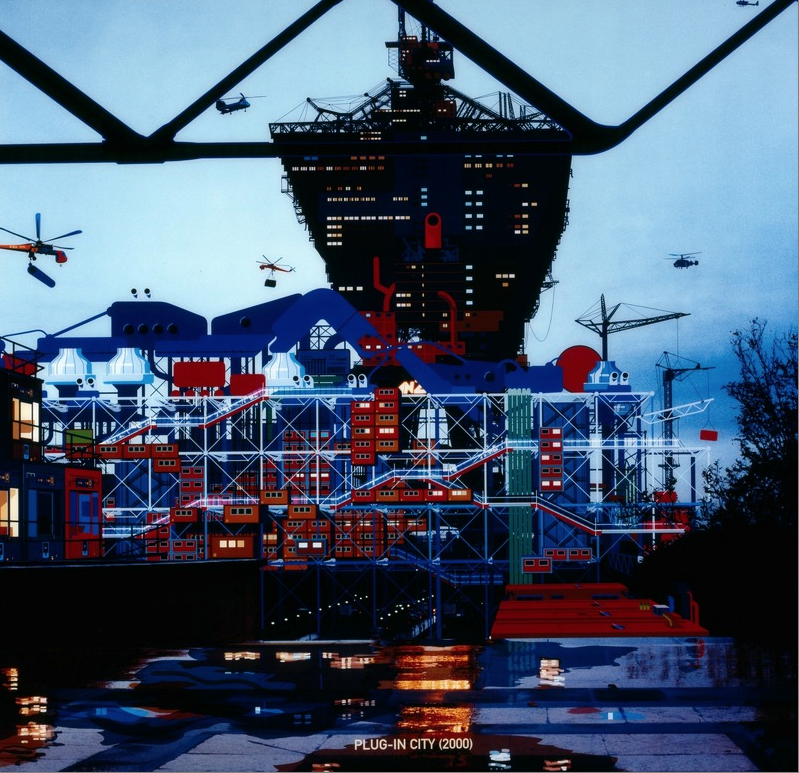Plug in City!! 2014, 2000, 1961…
Modulated housing, building on infrastructure, cities in transition…issues confronting many of the world’s great cities right now.
I recently stumbled across the work of artist Alain Bublex and his project ‘Plug In City’ which began in 2000.
His images are evocative of a moving, changing, dynamic urban world. A construction process that is never-ending, emphasised in his work by the cranes and helicopters flying in modules.
The idea he shares in his computer rendered photomontages is a utopian one he relates back to the ideas of Archigram, a group of British Architects working in the 1960s led by Peter Cook. The Archigram team explored the idea of modular building and super structures based on infrastructure as a response to the post-war housing shortage and the need to rebuild cities. The concept of modular building and its opportunities were highly popular in the post war period but Archigram in particular explored this concept through drawing and model making. In a few of Peter Cook’s sketches below we can see the origins of many of the forms in Alain Bublex’s work.
A ‘Plug in City’ as described by Archigram was one that grew through the additional of modules attached to existing and new infrastructure that created a highly visible super structure to support the functioning of the city.
The idea that Archigram and Peter Cook explored has influenced many architects and planners. The Pompidou Centre, Paris, exhibits some of Alain Bublex’s work, designed by Richard Rogers and Renzo Piano (1971-1977). The building itself explored the idea of modulation and controversially the supporting elements of the building formed the highly visible structure (a micro level exploration of the ideas). Fittingly in another if Bublex’s explorations above he shows the Pompidou Centre and its outer structure being extended and forming part of the super structure of the city.
Today, maybe modular building as an underpinning concept for urban planning has got a somewhat jaded name for itself and often in the same sentence as repetitive, cheap and boring, but oh the possibilities!!!....
Banner source: centrepompidou.fr
I recently stumbled across the work of artist Alain Bublex and his project ‘Plug In City’ which began in 2000.
 |
| Source: www.centrepompidou.fr |
Since 2000, artist Alain Bublex has been exploring the idea of modular additions to existing infrastructure in his work. He even takes it to the nth degree with the image above manipulating the Eiffel Tower with a series of modular additions!
His images are evocative of a moving, changing, dynamic urban world. A construction process that is never-ending, emphasised in his work by the cranes and helicopters flying in modules.
The idea he shares in his computer rendered photomontages is a utopian one he relates back to the ideas of Archigram, a group of British Architects working in the 1960s led by Peter Cook. The Archigram team explored the idea of modular building and super structures based on infrastructure as a response to the post-war housing shortage and the need to rebuild cities. The concept of modular building and its opportunities were highly popular in the post war period but Archigram in particular explored this concept through drawing and model making. In a few of Peter Cook’s sketches below we can see the origins of many of the forms in Alain Bublex’s work.
 |
| Source: www.archdaily.com/399329/ ad-classics-the-plug-in-city-peter-cook-archigram |
 |
| Source: www.centrepompidou.fr |
Today, maybe modular building as an underpinning concept for urban planning has got a somewhat jaded name for itself and often in the same sentence as repetitive, cheap and boring, but oh the possibilities!!!....
Banner source: centrepompidou.fr




Comments
Post a Comment